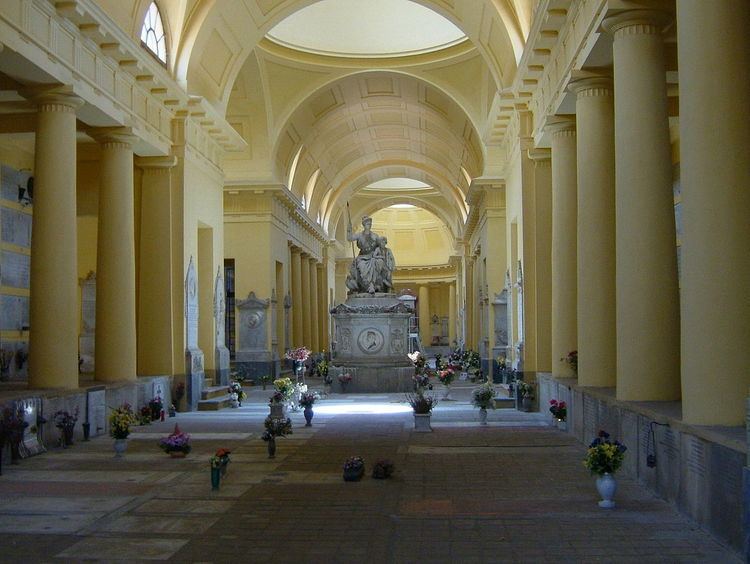Established 1334 Phone +39 051 615 0882 | Location Bologna Type Public Website Official website Province Province of Bologna | |
 | ||
Address Via della Certosa, 18, 40134 Bologna, Italy Hours Open today · 8AM–5PMWednesday8AM–5PMThursday8AM–5PMFriday8AM–5PMSaturday8AM–5PMSunday8AM–5PMMonday8AM–5PMTuesday8AM–5PM Similar Sanctuary of the Madonna, Palazzo d'Accursio, San Petronio Basilica, Basilica of San Francesc, Basilica di Santa Maria dei | ||
Cimitero monumentale della certosa di bologna
The Certosa di Bologna is a former Carthusian monastery (or charterhouse) in Bologna, northern Italy, which was founded in 1334 and suppressed in 1797. In 1801 it became the city’s Monumental Cemetery which would be much praised by Byron and others. In 1869 an Etruscan necropolis, which had been in use from the sixth to the third centuries BCE, was discovered here.
Contents
- Cimitero monumentale della certosa di bologna
- La certosa di bologna
- The church
- The cemetery
- Tombs
- References
The Certosa is located just outside the walls of the city, near the Stadio Renato Dall'Ara, at the foot of the Monte della Guardia and the Sanctuary of the Madonna di San Luca.
La certosa di bologna
The church
The church is dedicated to Saint Jerome (San Girolamo). The painting over the high altar is The Crucifixion by Bartolomeo Cesi; to the left is a Prayer in the Garden of Gethsemane and to the right a Deposition, also by Cesi. The wooden inlaid choir stalls were restored by Biagio De' Marchi in 1538 after a fire started by the Landsknechts of Charles V, Holy Roman Emperor. There is a series of large (450 x 350 cm) paintings of episodes from the life of Christ which were commissioned to Giovanni Andrea Sirani (Christ in the House of Simon, 1652), Elisabetta Sirani (The Baptism of Christ, 1658), Francesco Gessi (The Miraculous Draught of Fishes and The Expulsion from the Temple, 1645), Giovanni Maria Galli da Bibiena (The Ascension, 1651), Lorenzo Pasinelli (Entry into Jerusalem, 1657), Domenico Maria Canuti, and the Neapolitan Nunzio Rossi (Adoration of the Shepherds). There are paintings of several Carthusian martyrs including the Englishmen Blessed William Exmew, Blessed Thomas Johnson, Blessed Richard Bere, and Blessed Thomas Green.
Other works by Antonio and Bartolomeo Vivarini, Ludovico and Agostino Carracci, in addition to Guercino, were taken to Paris by Napoleon, and when returned to Bologna were deposited in the Pinacoteca Nazionale.
The cemetery
The public cemetery was established in 1801 using the pre-existing structure of the Certosa di San Girolamo di Casara, founded in the middle of the 14th century that was closed by Napoleon in 1797. The passion of the local nobility and aristocracy for monumental family tombs transformed the Certosa in an "open-air museum," a stage of the Italian grand tour: it was visited by Byron, Dickens, Theodor Mommsen, and Stendhal. In particular the third cloister (or that of the Chapel) is noteworthy a tour of neoclassicisminspired structures with simbology from the age of enlightenment. Some tombs are painted in tempera, others are made of stucco and scagliola.
An aspect that distinguishes the Certosa of Bologna from other monumental cemeteries of Europe is derived from the complex articulation of its use of space. To the original convent nucleus were added lodges, rooms, and porticos that recreate glimpses of a setting that recalls the city of the "living". Even the porticoed eastern entrance of the cemetery, which is linked to the one that leads to the Sanctuary of San Luca with only a small break, creates the continuity between necropolis and city.
The discovery of an Etruscan necropolis during archeological excavations organized by the engineer Antonio Zannoni in order to extend the cemetery at the end of the 19th century are now in the Civic Archeological Museum of Bologna.
Tombs
Among those buried in the Certosa are the following:
